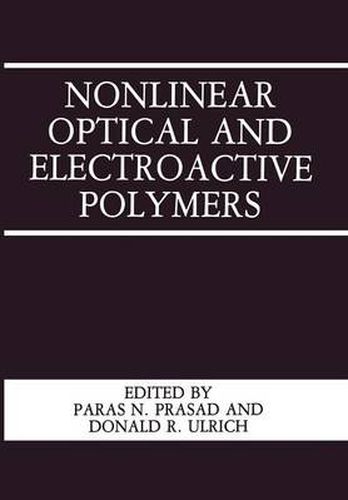Readings Newsletter
Become a Readings Member to make your shopping experience even easier.
Sign in or sign up for free!
You’re not far away from qualifying for FREE standard shipping within Australia
You’ve qualified for FREE standard shipping within Australia
The cart is loading…






This title is printed to order. This book may have been self-published. If so, we cannot guarantee the quality of the content. In the main most books will have gone through the editing process however some may not. We therefore suggest that you be aware of this before ordering this book. If in doubt check either the author or publisher’s details as we are unable to accept any returns unless they are faulty. Please contact us if you have any questions.
This treatise is a compendium of papers based on invited talks presented at the American Chemical Society Symposium on Electroactive Polymers which covered nonlinear optical polymers and conducting polymers, the common denominator being the correlated pi-electron structures. The improved understanding of the consequences of pi-electron delocalization upon nonlinear optical properties and charge carrier dynamics has laid the foundation for the rapid development and application of the electroresponse of conjugated polymers. As a result, the area of electroactive and nonlinear optical polymers is emerging as a frontier of sCience and technology. It is a multidisciplinary field that is bringing together scientists and engineers of varied background to interface their expertise. The recent explosion of interest in this area stems from the prospect of utilizing nonlinear optical effects for optical switching and logic operations in optical computing, optical signal processing, optical sensing and optical fiber communications. Polymers and organic are rapidly becoming one of the major material classes for nonlinear optical applications along with multiple quantum wells, ferroelectrics and other oxides, and direct band-gap semiconductors. The reasons for this lie in the unique molecular structures of polymers and organics and the ability to molecularly engineer the architecture of these structures through chemical synthesis.
$9.00 standard shipping within Australia
FREE standard shipping within Australia for orders over $100.00
Express & International shipping calculated at checkout
Stock availability can be subject to change without notice. We recommend calling the shop or contacting our online team to check availability of low stock items. Please see our Shopping Online page for more details.
This title is printed to order. This book may have been self-published. If so, we cannot guarantee the quality of the content. In the main most books will have gone through the editing process however some may not. We therefore suggest that you be aware of this before ordering this book. If in doubt check either the author or publisher’s details as we are unable to accept any returns unless they are faulty. Please contact us if you have any questions.
This treatise is a compendium of papers based on invited talks presented at the American Chemical Society Symposium on Electroactive Polymers which covered nonlinear optical polymers and conducting polymers, the common denominator being the correlated pi-electron structures. The improved understanding of the consequences of pi-electron delocalization upon nonlinear optical properties and charge carrier dynamics has laid the foundation for the rapid development and application of the electroresponse of conjugated polymers. As a result, the area of electroactive and nonlinear optical polymers is emerging as a frontier of sCience and technology. It is a multidisciplinary field that is bringing together scientists and engineers of varied background to interface their expertise. The recent explosion of interest in this area stems from the prospect of utilizing nonlinear optical effects for optical switching and logic operations in optical computing, optical signal processing, optical sensing and optical fiber communications. Polymers and organic are rapidly becoming one of the major material classes for nonlinear optical applications along with multiple quantum wells, ferroelectrics and other oxides, and direct band-gap semiconductors. The reasons for this lie in the unique molecular structures of polymers and organics and the ability to molecularly engineer the architecture of these structures through chemical synthesis.